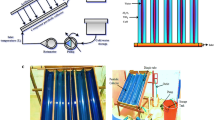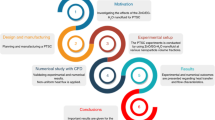Abstract
Recently, parabolic trough solar collector (PTSC) efficiency enhancement with nanoparticle concentrations has been identified as a potential research area. In this research, the performance of PTSC with dimple tube with TiO2/DI–H2O (De-Ionized Water) nanofluid has been analysed using computational fluid dynamics (CFD). The size of the nanoparticle was in the range of 10–15 nm. Different volume concentrations of the nanoparticles in the range of 0.1–0.5%, in steps of 0.1%, were chosen to prepare the nanofluids to carry out the experiments. Experimental and CFD analysis is compared to TiO2 nanofluid with water (base fluid) at varying mass flow rates (0.5, 1.0, 1.5, 2.0, 2.5 and 3.0 kg min−1) in a turbulent flow system using Dimples tube. Furthermore, PTSC parametric values were determined from test results such as friction factor, uncertainty analysis, Reynolds number, solar collector efficiency, Nusselt Number, and Convective heat transfer coefficient. In comparison, the convective heat transfer coefficient of the TiO2 nanofluids with the base fluid is increased to 34.25% with the dimples tube. The highest performance increase in PTSC with a mass flow rate of 2.5 kg min−1 and 0.3% volume concentration gives overall optimized results in absolute energy absorption, gradient temperature, and efficiency of the solar water heater. The nanofluid’s output index is 2.42 with a 0.3% mass flow rate and a concentration of 1.5 kg min−1. The PTSC with TiO2 nanofluid has a maximum overall efficiency of 34.25%, which is 11% higher than the overall efficiency of the base fluid. At a mass flow rate of 3.0 kg min−1 and 0.5% volume concentration, the pressure drop was increased by about 5.68% compared to the mass flow rate of 2.5 kg min−1.















Similar content being viewed by others
Abbreviations
- \({(C}_{\mathrm{P}}.\rho {)}_{{\mathrm{TiO}}_{2}}\) :
-
Collector heat gain (kJ K−1 m−3)
- \({\eta }_{\mathrm{c}}\) :
-
Collector efficiency (%)
- \(\frac{{T}_{\mathrm{O}}-{T}_{\mathrm{I}}}{{T}_{\mathrm{ref}}}\) :
-
Parameter of heat loss °C
- \(\frac{{U}_{\mathrm{L}}{F}_{\mathrm{R}}}{C}\) :
-
Parameter of removal energy (kg m2 s−2)
- \({\ni }_{\mathrm{V}}\) :
-
Velocity flow rate (m s−1)
- \({\ni }_{\mathrm{V}}\) :
-
Pressure drop (Pa)
- \({C}_{{\mathrm{P}}_{{\mathrm{TiO}}_{2}}}\) :
-
Specific heat capacity of nanofluid (kJ kg−1 K−1)
- \({C}_{\mathrm{p}}\) :
-
Specific heat capacity (kJ kg−1 K−1)
- \({F}_{\mathrm{R}}({\eta }_{c})=\alpha \tau ({F}_{\mathrm{R}})\) :
-
Indicates the energy parameter
- \({Q}_{\mathrm{g}}\) :
-
Collector efficiency (%)
- \({T}_{\mathrm{O}}\) :
-
Outer radiation temperature °C
- \({T}_{\mathrm{ref}}\) :
-
Overall temperature °C
- \({g}_{\mathrm{x}},{g}_{\mathrm{y}},{g}_{\mathrm{z}}\) :
-
Asymmetrical gravity component
- \({k}_{\mathrm{t}}\) :
-
Thermal conductivity of the working fluid (W m−1 K−1)
- \({\rho }_{{\mathrm{TiO}}_{2}}\) :
-
The density of titanium dioxide in (kg m−3)
- \(\Delta T\) :
-
Temperature gradient °C
- CFD:
-
Computational Fluid Dynamics
- DI-H2O:
-
De-ionized water
- F:
-
Friction factor
- IEA:
-
International energy agency
- Nu:
-
Nusselt number
- PTSC:
-
Parabolic trough solar collector
- Re:
-
Reynolds number
- TiO2 :
-
Titanium dioxide
- \(T\) :
-
Nanofluid initial temperature °C
- \(u , v, w\) :
-
Velocity vector
- \(\beta \rho\) :
-
Optimal efficiency
- \(\mu\) :
-
Momentum parameter (kg s−1)
- \(\varphi\) :
-
Convective heat transfer coefficient (W m−2 K−1)
References
Abed AM, Kareem DF, Majdi HS, Abdulkadhim A. Experimental and CFD Analysis of two-phase forced convection flow in channels of various rib shapes. J Adv Res Fluid Mech Therm Sci. 2021;77:36–50.
Potgieter MSW, Bester CR, Bhamjee M. Experimental and CFD investigation of a hybrid solar air heater. Sol Energy. 2020;195:413–28.
Arun M, Barik D, Sridhar K.P. and Vignesh G. Performance analysis of solar water heater using Al2O3 nano particle with plain-dimple tube design. Exp Tech 2022; 1–14
Dileep K, Raj A, Dishnu D, Saleel A, Srinivas M, Jayaraj S. Computational fluid dynamics analysis on solar water heater: Role of thermal stratification and mixing on dynamic mode of operation. Therm Sci. 2020;24(2PartB):1461–72.
Lamnatou C, Papanicolaou E, Belessiotis V, Kyriakis N. Experimental investigation and thermodynamic performance analysis of a solar dryer using an evacuated-tube air collector. Appl Energy. 2012;94:232–43.
Liu ZH, Hu RL, Lu L, Zhao F, Xiao HS. Thermal performance of an open thermosyphon using nanofluid for evacuated tubular high temperature air solar collector. Energy Convers Manag. 2013;73:135–43.
Kumar A, Kumar S, Nagar U, Yadav A. Experimental study of thermal performance of one-ended evacuated tubes for producing hot air. J Sol Energy. 2013;2013:1–6.
Xu L, Wang Z, Yuan G, Li X, Ruan Y. A new dynamic test method for thermal performance of all-glass evacuated solar air collectors. Sol Energy. 2012;86:1222–31.
Tong Y, Kim J, Cho H. Effects of thermal performance of enclosed-type evacuated U-tube solar collector with multi-walled carbon nanotube/water nanofluid. Renew Energy. 2015;83:463–73.
Mahian O, Kolsi L, Amani M, Estellé P, Ahmadi G, Kleinstreuer C, Marshall JS, et al. Recent advances in modeling and simulation of nanofluid flows-Part I: fundamentals and theory. Phys Rep. 2019;790:1–48.
Verma SK, Tiwari AK, Chauhan DS. Experimental evaluation of flat plate solar collector using nanofluids. Energy Convers Manag. 2017;134:103–15.
Kaya H, Ekiciler R, Arslan K. Entropy generation analysis of forced convection flow in a semicircular microchannel with TiO 2/water nanofluid. Heat Transf Res. 2019;50(4):335–48.
Ekiciler R, Arslan K, Turgut O, Kurşun B. Effect of hybrid nanofluid on heat transfer performance of parabolic trough solar collector receiver. J Therm Anal Calorim. 2021;143:1637–54.
Thansekhar MR, Anbumeenakshi C. Experimental investigation of thermal performance of microchannel heat sink with nanofluids Al2O3/Water and SiO2/Water. Exp Tech. 2017;41:399–406.
Kayhani MH, Soltanzadeh H, Heyhat MM, Nazari M, Kowsary F. Experimental study of convective heat transfer and pressure drop of TiO2/water nanofluid. Int Commun Heat Mass Transf. 2012;39:456–62.
Sajadi AR, Kazemi MH. Investigation of turbulent convective heat transfer and pressure drop of TiO2/water nanofluid in circular tube. Int Commun Heat Mass Transf. 2011;38:1474–8.
Arani AA, Amani J. Experimental investigation of diameter effect on heat transfer performance and pressure drop of TiO2–water nanofluid. Exp Therm Fluid Sci. 2013;44:520–33.
Duangthongsuk W, Wongwises S. An experimental study on the heat transfer performance and pressure drop of TiO2-water nanofluids flowing under a turbulent flow regime. Int J Heat Mass Transf. 2010;53:334–44.
Azmi WH, Sharma KV, Sarma PK, Mamat R, Najafi G. Heat transfer and friction factor of water-based TiO2 and SiO2 nanofluids under turbulent flow in a tube. Int Commun Heat Mass Transf. 2014;59:30–8.
Sahin B, Gültekin GG, Manay E, Karagoz S. Experimental investigation of heat transfer and pressure drop characteristics of Al2O3–water nanofluid. Exp Therm Fluid Sci. 2013;50:21–8.
Elkoumy SR, Barakat EI, Abdelsalam SI. Hall and transverse magnetic field effects on peristaltic flow of a Maxwell fluid through a porous medium. Global J Pure Appl Math. 2013;9:187–203.
Abdelsalam SI, Zaher AZ. Leveraging elasticity to uncover the role of rabinowitsch suspension through a wavelike conduit: consolidated blood suspension application. Mathematics. 2021;9:2008.
Bhatti MM, Alamri SZ, Ellahi R, Abdelsalam SI. Intra-uterine particle–fluid motion through a compliant asymmetric tapered channel with heat transfer. J Therm Anal Calorim. 2021;144:2259–67.
Abdelsalam SI, Velasco-Hernández JX, Zaher AZ. Electro-magnetically modulated self-propulsion of swimming sperms via cervical canal. Biomech Model Mechanobiol. 2021;20:861–78.
Eldesoky IM, Abdelsalam SI, El-Askary WA, Ahmed MM. The integrated thermal effect in conjunction with slip conditions on peristaltically induced particle-fluid transport in a catheterized pipe. J Porous Med. 2020;23:7.
Eldesoky IM, Abdelsalam SI, El-Askary WA, El-Refaey AM, Ahmed MM. Joint effect of magnetic field and heat transfer on particulate fluid suspension in a catheterized wavy tube. BioNanoSci. 2019;9:723–39.
Abd Elmaboud Y, Abdelsalam SI. DC/AC magnetohydrodynamic-micropump of a generalized Burger’s fluid in an annulus. Phys Scr. 2019;94:115209.
Raza R, Mabood F, Naz R, Abdelsalam SI. Thermal transport of radiative Williamson fluid over a stretchable curved surface. Therm Sci Eng Progr. 2021;23:100887.
Bhatti MM, Marin M, Zeeshan A, Abdelsalam SI. Recent trends in computational fluid dynamics. Front Phys. 2020;8:593111.
Abumandour RM, Eldesoky IM, Kamel MH, Ahmed MM, Abdelsalam SI. Peristaltic thrusting of a thermal-viscosity nanofluid through a resilient vertical pipe. Zeitschrift für Naturforschung A. 2020;75:727–38.
Bhatti MM, Abdelsalam SI. Thermodynamic entropy of a magnetized Ree-Eyring particle-fluid motion with irreversibility process: a mathematical paradigm. ZAMM-J Appl Math Mech/Zeitschrift für Angewandte Mathematik und Mechanik. 2021;101:202000186.
Acknowledgements
The authors sincerely thank Karpagam Academy of Higher Education (Deemed to be University), Coimbatore, India, for providing the necessary facilities to carry out this research work.
Author information
Authors and Affiliations
Corresponding author
Ethics declarations
Conflict of interest
On behalf of all authors, the corresponding author states that there is no conflict of interest.
Additional information
Publisher's Note
Springer Nature remains neutral with regard to jurisdictional claims in published maps and institutional affiliations.
Rights and permissions
Springer Nature or its licensor holds exclusive rights to this article under a publishing agreement with the author(s) or other rightsholder(s); author self-archiving of the accepted manuscript version of this article is solely governed by the terms of such publishing agreement and applicable law.
About this article
Cite this article
Arun, M., Barik, D. & Sridhar, K.P. Experimental and CFD analysis of dimple tube parabolic trough solar collector (PTSC) with TiO2 nanofluids. J Therm Anal Calorim 147, 14039–14056 (2022). https://doi.org/10.1007/s10973-022-11572-5
Received:
Accepted:
Published:
Issue Date:
DOI: https://doi.org/10.1007/s10973-022-11572-5




